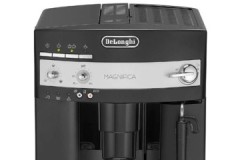Valuable recommendations on how to clean the heating element of a water heater from scale
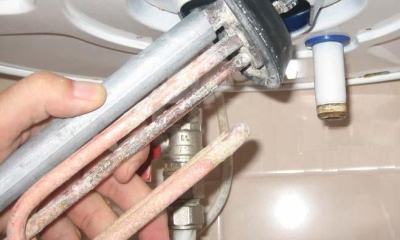 Modern water heating devices make human life much easier. But in order to extend the period of perfect operation of boilers, it is necessary to regularly monitor their condition.
Modern water heating devices make human life much easier. But in order to extend the period of perfect operation of boilers, it is necessary to regularly monitor their condition.
The number of care procedures includes cleaning the heating element from limescale. There are many tools and methods for descaling. These include folk recipes and ready-made household chemicals.
How to clean the heating element of a water heater from scale, read the article.
Content
Why clean?
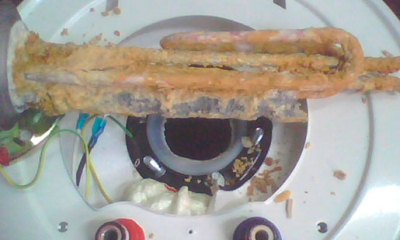 In the process of heating the water, some of the salts contained in it precipitate and accumulate on the inner walls of the boiler and the water heating element.
In the process of heating the water, some of the salts contained in it precipitate and accumulate on the inner walls of the boiler and the water heating element.
Limescale is characterized by low thermal conductivity, therefore, as it accumulates, the water heating time is lengthened.
This fact brings significant inconvenience while using the device. But, unfortunately, this is not the only negative consequence of scale build-up.
Long-term operation of the boiler leads to an increase in energy consumption, and, therefore, money spending. In addition, the load on the device itself increases.
If you do not clean the heating element from salt deposits, then the risk of equipment breakdown increases significantly. Clogging also affects the quality of the hot water consumed. Flaky inclusions appear in it, which are not always pleasant for hygienic procedures.
How often?
Experts recommend preventive cleaning of the heating element once a year.... If the device works with increased load, it is advisable to increase the frequency up to twice a year.
In this case, it is always necessary to monitor the operation of the water heater. There are several signs that indicate the need for cleansing.
 The time for cleaning has come if:
The time for cleaning has come if:
- water heats up longer than usual;
- increased power consumption;
- the device makes noise during operation;
- the body and sockets get very hot;
- the water has acquired a yellowish tint;
- a hydrogen sulfide smell appeared in the water;
- the boiler turns on and off.
If a white coating remains on the taps, it means that the water hardness is increased.In this case, the water heater requires more careful maintenance.
How to disassemble a boiler?
Before proceeding directly to the cleaning procedure, the device must be disassembled and the water heating element removed from it.
Disassembly work is carried out following a certain algorithm:
- The device is disconnected from the power supply.
- Shut off the pipe through which the water is supplied.
- Close the cold flow valve near the boiler.
- Open a hot water tap on the near mixer.
- A hose is connected to the drain fitting and water is released.
- Remove the water heater from the wall, turn it over.
- Unscrew the mounting bolts from the tank pan.
- Remove the panel and take out the thermostat holder.
- Unscrew the screws on the protective door and remove it.
- Disconnect the contacts, while freeing the wires.
- Remove the rubber seal.
- Take out the heating element.
How to get the heating element out?
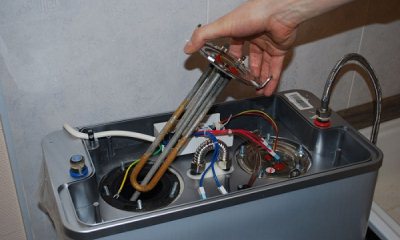 The process of removing the heating element must be very careful. This rule is especially important to observe if cleaning has not been carried out for a long time.
The process of removing the heating element must be very careful. This rule is especially important to observe if cleaning has not been carried out for a long time.
Significant build up of deposits may prevent quick access to the element, and sudden movements can provoke damage.
Having taken out the heating block, it is also necessary to inspect the magnesium anode. If the degree of its depletion is close to maximum, then it is advisable to immediately replace this element with a new one. Otherwise, after a while, you will have to repeat the disassembly of the unit.
How to remove limescale deposits?
The removed heating element is cleaned in two ways: mechanical and chemical... If the lime deposits are thick, then both methods are used together.
First, coarse deposits are removed from the tubular part using physical efforts, and then the remaining limescale traces are removed chemically.
For this, a cylindrical container (for example, an enamel bucket) is filled with a cleaning liquid and the heating element is lowered there. The exposure time depends on the nature of the reagent.
How to remove folk remedies?
To dissolve the solid salt sediment on the heating element, it is necessary to use substances with an acidic reaction. Used as household cleaners:
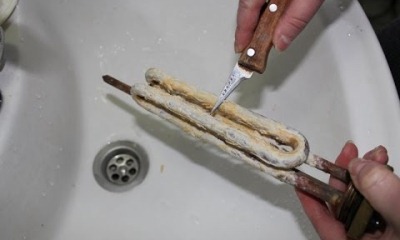 Lemon acid... Pour two 25-gram sachets of powder into a liter of water. When all the crystals have dissolved, a heating element is lowered into the solution. Withstand a day, after which the heating element is washed in clean water.
Lemon acid... Pour two 25-gram sachets of powder into a liter of water. When all the crystals have dissolved, a heating element is lowered into the solution. Withstand a day, after which the heating element is washed in clean water.- Acetic acid... If a solution of vinegar of medium concentration (9%) is used for cleaning, then take 5 tablespoons per liter of water.
If only essence is available, then its amount should be 2 tablespoons for the same volume of water. The holding time is 10-12 hours.
- Mechanical cleaning... To remove limestone, use a metal brush, scraper, sandpaper. The method is laborious and cannot be used to clean the anode.
If there is too much scale, then the amount of reagent can be increased, and a metal container with a solution and heating element can be put on low heat and heated for 30-60 minutes.
How to remove plaque with household chemicals?
Ready-made liquids sold in household chemicals stores are distinguished by a special composition that guarantees the effectiveness of cleaning. Different companies are engaged in the release of such products:
- Boiler Cleaner... Acid product from the firm "Clean". The liquid is used against carbonate salts, iron oxide. The composition includes a complex of acids, an anticorrosive additive and substances that enhance the effect of basic reagents. To clean the contaminated surface, the liquid is mixed with water to obtain a concentration of 5 to 12%. The heating element is lowered into the solution and kept for 8 hours. The cost of a 5 liter canister averages 480 rubles.
- SteelTEX... The formula of the product includes surfactants, corrosion inhibitor additives. The liquid helps to remove metal oxides, salts, rust, biological inclusions from the heating element. According to the instructions for use, SteelTEX is diluted with water in a ratio of 1: 6 to 1:10. The stronger the contamination, the stronger the solution must be. After washing, use an alkaline neutralizer. The price of the product (20 kg) is about 4200 rubles.
- Cillit ZN / I... This reagent from a German manufacturer is designed to fight rust, lime salts. To process heating elements, a solution is prepared from 1 part of the product and 9 parts of water. The part is kept in the solution for 1-4 hours at a temperature of 20 to 40 degrees. Heating is allowed if necessary. The average cost of a 20 kg canister is 10,700 rubles.
How to assemble the tank?
The assembly of the device is carried out in the reverse order. To do this, it is important to remember in what sequence the actions were performed during dismantling. The clean heating element and the flange are returned to their place, the rubber gaskets are laid, the contacts are restored and the protective door is screwed on.
Features for devices from different manufacturers
The general scheme for removing the water heating element may have minor adjustments depending on the brand of the boiler. They are due to the individual structure of the device and the installation method of the heating element. Disassembly features are available for the following boilers:
- Ariston. To remove the cover with the heating element, you must first insert it inside the case. If the part does not yield, it is slightly rocked and try again. The heating element is taken out sideways as it has a curved shape. On some models, this part needs to be turned counterclockwise.
-
 Burning. To remove the front panel on the tank, you need to lightly press its bottom edge and pull it towards you. After the latches have worked, the panel is removed.
Burning. To remove the front panel on the tank, you need to lightly press its bottom edge and pull it towards you. After the latches have worked, the panel is removed.Boilers of this company stand out for their heavy weight, so it is better to lift and turn the device together.
- Polaris. Models of this brand are distinguished by the difficulty of removing the heating part. First, the holding bracket is unscrewed in the device and only after that the heating element is removed. They take him out at an angle, as if taking him to the side.
- Atlantic and Termex... In water heaters of these brands, first unscrew the nuts located around the circumference of the tank. Then remove the fastening washer. The flange on which the heating element is fixed is lowered down. The heating element is taken out carefully, with shaking movements.
Tips on the topic of the article
Cleansing the heating element of the boiler from accumulated lime deposits is an important and mandatory measure. To reduce the frequency of the procedure, experts recommend listening to practical advice:
- if there is no need for heating water, it is advisable to turn off the water heater;
- before turning on the device, you need to check whether the tank is filled with water;
- if the water pressure in the system has dropped, you should not turn on the boiler at full capacity;
- it is recommended to install main or other water filters in the house;
- to disinfect the tank, weak heating (up to 40 degrees) must be alternated with strong (up to 90 degrees);
- the regularity of preventive cleaning of the heating device must be observed.
If you are interested in how to descale various household appliances, take a look here.
Useful video
How to clean the heating element of a water heater with your own hands, video instruction:
Conclusion
To keep the water heater in working order for a long time, it is necessary to periodically descale its heating element. For this purpose, folk and store remedies are suitable.
In any case, before cleaning, the heating element and its protecting parts should be dismantled from the structure, and after cleaning, restore the integrity of the device and check its tightness.

